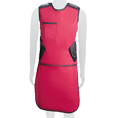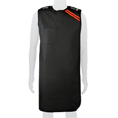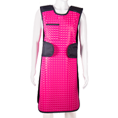- No products in the cart.
Radiation Protection Eyewear
Introducing Safeloox, Deutsch Medical's new Safety Eyewear brand - protecting the vision of all healthcare professionals...


The eyes are the most sensitive area of the body to radiation and susceptible to damage by exposure during diagnostic imaging procedures and work around type of imaging equipment, risking the development of lens opacities and cataracts. Deutsch Medical's Lead Glasses protect the eyes of healthcare professionals who work in areas such as cardiac electrophysiology (EP) and catheterisation laboratories, radiology, orthopaedic surgeries, urologic procedures, pain management and furthermore, from harmful x-ray and scattered radiation.
Deutsch Medical offer a comprehensive range of stylish Lead Glasses designed to provide comfortable protection and to fit various face shapes. Choose between standard, prescription, low-fit or 'fit over prescription' lead glasses. Improve your vision by adding optional extras, such as anti-fog to minimise fog or anti-reflective coatings that reduces glare. Find a perfect fit for your unique features and choose from our categories below.

Non-Prescription
Lead Glasses
Protecting your eyes from radiation with a complete range of modern and lightweight lead glasses.

Prescription
Lead Glasses
Providing protection for eyes that require near and/ or distance vision.

Low-Fit
Lead Glasses
Designed to fit comfortably on faces with a lower nose bridge and away from cheekbones.

Fitover
Lead Glasses
Lead glasses that fit over your standard prescription eyewear.
Your Benefits
Lightweight & Comfortable
Keeping your eyes fully protected and comfortable with lightweight lead glasses even throughout long procedures.
Individual Fit
Choose from more than 50 stylish frame options and various colours to fit your individual face shape.
Prescription Lead Glasses
Offering prescription lead glasses to suit any script, including single vision, bifocal and progressive prescription lenses.
Protection
Protecting you with 0.75mm Pb leaded lenses and 0.50mm Pb leaded side shields providing highest protection against x-ray radiation.
Peace of Mind
Giving you personal confidence in the high quality of our leaded lenses and frames by offering a 2-Year-Guarantee on materials and workmanship.
Highest Industry Standards
Conforming with AS/ NZS 4543.3:2000 and ALL major global standards: IEC 61331-3:2014, ASTM F2547 and DIN 6867-2, CE 0598.
Free Trial-Before-You-Buy for All Lead Glasses
Making it easy to find your lead glasses that best fit and protect you

1. 'Virtual Try On' Option (VTO)
Helping you to choose lead glasses.
Showing you online how you look with our lead glasses on and how they fit as the VTO responds to your movements and allows you to see how the lead glasses look at different angles.
Try On Our Glasses Virtually2. 'Real Try On' Option
Ensuring you are happy with your choice and investment.
Experiencing the weight and comfort of your lead glasses by trialling up to 5 pairs of lead glasses (pre-selected through VTO) at home or in your workplace for a period of 7 days.
Claim Your Free TrialRadiation Exposure and Dose Recommendations
Lead Glasses provide radiation protection against x-ray radiation from scattered radiation in areas such as electro physiology, orthopaedic surgery, radiology, catheterisation laboratories, urologic procedures and veterinary surgery. According to The University of Toronto ionising radiation can arise from:
- Primary emissions of x-ray producing machines used for medical and dental applications and analytical x-ray instruments that is used for diffraction and fluorescent studies.
- Secondary emissions and scattering of x-rays from the sample, shielding material and screens.
- Faulty high-voltage vacuum-tube rectifiers may emit x-rays.
- Leakage of primary or scattered x-rays through gabs and cracks in shielding and from faulty shutter, beam traps or collimator couplings.1

The Australian Radiation and Nuclear Protection Association (ARPANSA) have made a series of recommendations specifically related to Radiation protection of the eyes. They recommend lead glasses with 0.75mm lead (Pb) equivalence and the use of side shields. 2
"According to today's knowledge, early stages of radiation-induced cataracts can occur already from a radiation exposure level of 0.5 Gy."3,4 "Regardless of whether the dose occurs acutely or over an extended period, the effect is cumulative, single doses accumulate."3 As a result, "the IRCP Commission now recommends an equivalent dose limit for the lens of the eye of 20 mSv in a year, averaged over 5 years, with no single year exceeding 50 mSv."5 This means for many radiation users that the radiation dose limit could be reached across their working life.
Workplaces and medical staff are encouraged to adopt changes in advance of regulatory change to avoid or minimise health risks of radiation induced eye lens injury to medical workers. If medical workers and workplaces are advised, taught of and execute the ALARA (As Low As Reasonably Achievable) radiation protection principle designed to minimise radiation exposure (minimise time, double distance to source, use of shielding tools) it is still possible for medical staff (regularly exposed to radiation) to keep the annual radiation dose in the range of 0 to 5 mSv (against 20 mSv, that is the dose limit) in a busy medical facility
References:- Radiation Safety for X-Ray Units, Available Online, August 2020
- ARPANSA Fact Sheet, Improving Eye Safety in Image Guided Interventional Procedures (IGIP), Available online, March 2015
- SSK: Radiation-induced cataracts, recommendation of the Radiation Protection Commission with scientific justification [conference]. - Bonn, May 14th, 2009. - 234th edition Session of the Radiation Protection Commission on May 14th, 2009. - P. 9, 18, 21
- Radiological Protection Ordinance: Ordinance on protection against damage caused by ionising radiation [Ordinance]. - October 2011 - P. 31, 32, 34
- (1) ICRP (2011), Statement on Tissue Reactions, Available online, September 2019
Radiation Protection for Lead Glasses with Prescription
Deutsch Medical is specialises radiation protection frames that can be fitted with prescription leaded lenses allowing for three prescription types. These lead glasses frames have been selected with adequate temporal coverage in mind to have leaded side shields affixed to protect you from ionising radiation coming from the side and to meet ARPANSA's recommendations.
Single Vision (SV)
Leaded Lenses

Providing radiation protection for healthcare professionals who are farsighted or nearsighted. SV leaded lenses only offer one type of vision correction.
Bifocal Vision (BF)
Leaded Lenses

Protecting eyes of healthcare professionals who need both near and distance vision. BF leaded lenses are split into two sections to correct near and far visual needs.
Progressive Vision (PG)
Leaded Lenses

Offering protection for healthcare professionals who require three levels of vision in one: distance, intermediate and near, allowing to do close-up work, middle-distance work or distance viewing without needing to change your glasses.
Frame Selection
Your script, usually measured and prepared by an Optometrist or Ophthalmologist, determines which frame will be most suitable as there are some limitations to the scripts which can be made with leaded glass. For instance, wraparound (curved) frames only allow for a light prescription (dioptre limit +/-3). Frames that can be equipped with the majority of scripts are the ones that have a flat front (no curve). Each product page includes a detailed overview of prescription limits.
Weight Considerations
Prescription lead glasses can often be heavier than non-prescription lead glasses, especially bifocal and progressive lead glasses as the lenses are laminated and thicker as a consequence. The higher your prescription is, the thicker the leaded lenses will be. As every script is unique, we can only provide you with an estimated weight range which is usually between an additional weight of 10 to 20grams. For instance, a pair of non-prescription lead glasses (leaded lenses and frame) weighs 65grams, the final approximate weight of your prescription lead glasses (prescription leaded lenses and frame) will weigh approximately 75 to 85grams.
Fitover Lead Glasses
If your script has a dioptre of higher than +/-8, we usually recommend to wear lead glasses that “fit over" standard prescription eyewear for two reasons: 1) Prescription leaded lenses cannot be manufactured past this limit, 2) the weight of the prescription leaded lenses becomes so significant that the lead glasses will be uncomfortable to wear.










